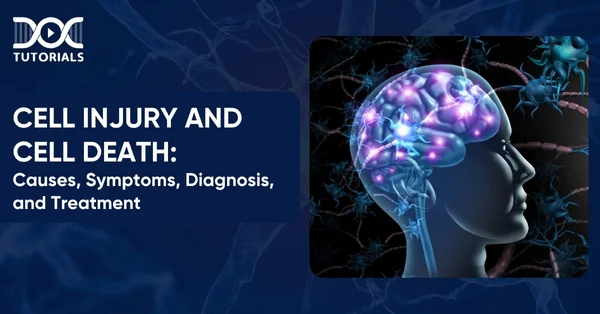Cell Injury and Cell Death: Mechanisms, Types, and Causestoms, Diagnosis, and Treatment

Cell injury and cell death are principal concepts in pathology. A cell’s capacity to achieve homeostasis is put at risk by a myriad of stimuli—both intracellular and extracellular. When such a balance is lost, it results in either reversible or irreversible cell injury, eventually leading to cell death.
These cellular reactions are central to a variety of clinical disorders, such as myocardial infarction, stroke, infection, and neoplasia. Aspiring medical students planning to sit for the NEET PG exam need to be well aware of cellular functions, including cell division, cell injury, and cell death.
To help them out, here is an in-depth NEET PG guide by DocTutorials. Keep reading!
What is Cell Injury?
Cell injury is any disruption of normal cell structure or function caused by noxious stimuli like physical trauma, toxins, infection, or genetic damage. It occurs when a cell’s protective responses are overwhelmed or unable to cope with stress.
Depending on the nature and duration of the damage, the injury may be reversible or evolve into permanent damage, resulting in cell death. Having a thorough understanding of cellular injury is crucial in comprehending the pathophysiology of most diseases.
What are the Different Types of Cell Injury?
Discussed below are the types of cell injury that are generally categorised into reversible and irreversible types:
- Reversible Cell Injury
Reversible cell injury occurs when cells experience a brief period of ischaemia or hypoxia. In this type of injury, the cells undergo changes in response to various stressors but may recover if the cause is eliminated or properly managed. Reversible cell injury is classified into a few types, which include:
- Cell Swelling (Hydropic Degeneration): Dysfunction of ion homeostasis leads to water sequestration and cytoplasmic vacuole formation. This is usually the first sign of reversible cell damage.
- Lipid Accumulation: The sequestration of excess lipids in the cytoplasm interferes with cellular metabolism, often in the liver and heart during metabolic distress. If this situation worsens, it can lead to lipotoxicity.
- Membrane Damage: Although it is temporary, minor damage to the plasma membrane increases permeability and may lead to leakage, but it can be repaired if detected early.
- Glycogen Depletion and Enzyme Dysfunction: Energy deficits caused by mitochondrial dysfunction lead to depleted glycogen stores and compromised enzyme activity, thereby impairing normal functioning.
- DNA Damage and Reversible Protein Denaturation: There are minor structural DNA and protein changes, which can be repaired by the cell if the injurious agent is removed.
- Irreversible Cell Injury
Irreversible cell injury is a severe type of cell damage in which the cell cannot recover and ultimately dies. This happens when the damage to the cell is greater than its ability to fix itself, resulting in cell death. It is classified into several types:
- Apoptosis: Apoptosis is a regulated, energy-requiring process of programmed cell death initiated by stimuli such as DNA damage or cellular stress. It can preserve tissue homeostasis, suppress cancer, and restrict inflammation and is critical in immune defence by removing infected or damaged cells.
- Necrosis: It refers to a form of cell death that is not regulated, leading to the swelling of organelles, rupture of the plasma membrane, and ultimately the lysis of the cell.
- Autophagy: The cell degrades its own structures in response to starvation or stress. Protective in the short term, but excessive autophagy is fatal.
- Oxidative Stress: An overload of reactive oxygen species (ROS) causes damage to proteins, lipids, and nucleic acids, potentially leading to apoptosis or necrosis.
- Ischaemia and Hypoxia: Prolonged lack of oxygen and nutrients leads to energy failure, membrane destruction, and irreversible structural damage.
What are the Mechanisms of Reversible Cell Injury?
Here are the mechanisms of reversible cell injury:
- Hydropic Degeneration (Cell Swelling): Microscopic evaluation shows the presence of vacuoles in the cytoplasm. In extreme cases, the cell fills with fluid and ruptures, leading to cellular death.
- Damage to the Cell Membrane: Damage to the plasma membrane leads to the leakage of cell contents and the entry of toxic substances.
- Glycogen Depletion: Decreased glycogen is caused by increased energy requirements or decreased production of energy.
- Reversible Protein Denaturation: Proteins can undergo alterations due to stress but revert to their normal state upon the removal of the stress factor.
- Mitochondrial Dysfunction: Oxidative phosphorylation and ATP production can be impaired, resulting in reduced energy within the cell.
What are the Mechanisms of Irreversible Cell Injury?
Discussed below are the mechanisms of irreversible cell injury:
- Severe Cell Membrane Damage: Severe damage to the plasma membrane can result in loss of cell material and influx of toxic substances.
- DNA (Deoxyribonucleic Acid) Damage: Severe and irreversible damage to DNA has the potential to initiate programmed cell death (apoptosis) or necrosis.
- Mitochondrial Permeability Transition: Perforation of the mitochondrial membrane has the ability to induce the release of pro-apoptotic factors and additional energy loss.
- Severe ATP (Energy) Depletion: Prolonged and extreme depletion of ATP or energy can cause irreparable cell dysfunction and death.
- Lysosomal Breakdown: The leakage of lysosomal enzymes into the cytoplasm can induce cell digestion and cell death (necrosis).
What are the Causes of Cell Injury?
Cell injury is caused by a variety of noxious stimuli that interfere with the normal structure or function of cells. Here are some of the reasons:
- Physical Damage: Physical trauma, extreme temperatures (burns or frostbite), and exposure to radiation can damage cell membranes and organelles, thereby initiating the pathogenesis of cell injury.
- Chemical Injury: Poisonous chemicals, such as drugs and environmental toxins, inhibit cellular metabolism or membrane integrity and result in functional impairment or death.
- Biological Agents: Infectious agents like bacteria, viruses, and fungi evoke immune reactions or release toxins, causing direct cell injury pathology. Autoimmune responses may also inadvertently act against normal cells.
- Oxygen Deficiency (Hypoxia and Ischaemia): Impaired oxygen supply (hypoxia) or total elimination of blood flow (ischaemia) is a primary reason for reversible and irreversible cellular damage, particularly in organs with high oxygen demands, such as the brain and heart.
- Nutrient Deficiencies: Both a lack and an excess of essential nutrients (like vitamins, proteins, and minerals) disrupt cellular functions and cause harm.
- Ageing: Cellular damage and lowered repair capacity through time are some of the most common reasons that can lead to cell injury or even cell death. Besides, the shortening of telomeres and protein deposition can also cause age-related cell injury.
What Do You Mean by Cell Death?
Cell death is a biological process that is natural and critical, where the cell permanently stops functioning and is removed. Although cell death is often perceived as a negative process, it is crucial in maintaining tissue homeostasis and health.
In a healthy human, numerous cells die on a daily basis in a regulated way to remove damaged, old, or unnecessary cells and replace them with new ones. When the processes of regulated cell death are not functioning properly, either too many cells die or unstable cells are not removed, leading to disease and dysfunction.
FAQs About Cell Injury and Cell Death
- How does cellular injury result in cell death?
A subsequent reduction in the cell’s intracellular pH occurs, which triggers detrimental enzymatic activities. This is followed by the early aggregation of nuclear chromatin, referred to as pyknosis, ultimately resulting in cell death.
- How do immune responses lead to cell injury?
Inflammatory cells release cytokines, growth factors, and degradative enzymes into the extracellular space where they are generated. These agents are capable of damaging parenchymal cells in inflamed tissues, possibly leading to cell death.
- What is cellular adaptation in pathology?
Cellular adaptation in pathology refers to the changes made by the cells in response to numerous stimuli in their local environment. This may include changing their morphological appearance or the number of cells.
- What are the two primary forms of cell death?
Necrosis and apoptosis are two major forms of cell death in the body. Generally, necrosis occurs due to injury, leading to uncontrolled cell death, while apoptosis is a controlled process.
- What is the most prevalent cause of cell injury?
Hypoxia, which refers to a decrease in oxygen availability, is among the most frequent causes of cell injury.
- What is the difference between reversible and irreversible cell injury?
The key difference between reversible and irreversible cell injury is that reversible cell injury involves cell damage that is recoverable once the stimulus is removed, while irreversible cell injury causes cell death.
Conclusion
Cell injury and death of cells are pivotal in the pathogenesis of many diseases and are dependent on a vast range of biochemical and structural alterations. Understanding reversible and irreversible injury and the complex pathways leading to necrosis and apoptosis is crucial for medical students and practitioners.
These concepts are the basis upon which one can diagnose and manage conditions with cell damage. DocTutorials offers top-notch, systematically devised study materials and visual representations that make complex subjects like cell injury pathology easier to understand, enabling NEET PG aspirants to master them effectively and crack the exam with confidence. Check out our NEET PG courses today!
Latest Blogs
-

NEET PG Exam 2025- Date, Pattern, Marking Scheme, Subject Wise Weightage, and Exam Mode
NEET PG Exam 2025 is the ultimate gateway for medical graduates aspiring to pursue postgraduate courses in medicine, including MD,…
-

INI CET Exam 2025: Your Roadmap to Success – Key Topics, Strategies, and Lessons from Last Year’s Papers
The INI CET exam is more than just a test; it’s a significant milestone for many medical students aiming to…
-

INI CET Exam Success: Previous Year Question Papers & Ultimate Guide – INI CET PYQ
One can feel overwhelmed while preparing for the INI CET (Institute of National Importance Combined Entrance Test). A vast syllabus,…




